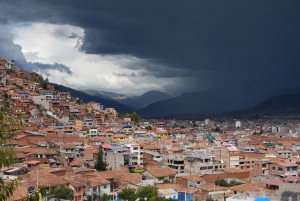Machus and How Cuzco Relates to Its Past

A city that pours out from the hillside on which the great fortress-temple Sacsayhuaman lies like a massive serpent to fill the Huatanay Valley, Cuzco holds an intriguing relationship with the past. To be sure, it makes its living because of its heritage as the city of the Incas but among its steeply staired streets and under its orange roofing tiles a different notion of the past rules.
Cuzco was the capital of Empire and that history is not only in the finely fitted stone walls or int he documents that ethnohistorians mine, it is in the lives of Cuzco’s people. When people get together, whether in family or with friends over beers or chichas, they talk. They tell stories about their lives and those around them and many of those stories have to do with the past.
Here is an example of one such story.
“When my grandfather was dividing up his land among his children, so they could build houses there was this very big rock. People wanted to use all the land for houses but the could not because of the rock.
“They dug down and tried to break it but they could not. After a while they found a spot where their picks would break because it was so hard.

“People started noticing that machus were appearing in the area. They say that they are tall, old people with beards and hats. They are really mean. They just want to scare people and make them flee, especially women.
“In the neighborhood they said that a machu had raped a woman. They say he entered at night, wearing the clothes of her husband. But it wasn´t the husband, it was one of the machus and the woman was made pregnant from him.

“The machus would try to push people down into holes, into the underground where they lived. My dad said that he had a machu grab him by the throat and try to pull him into a hole when he went into the bushes to use the bathroom. They didn’t have indoor bathrooms in that part of the city then. My aunt happened along, and saw the machu pulling at my father and scared it off. Machus are afraid to have women see them.
“But my grandfather did not want to believe in those things. Instead he just pushed ahead the excavation. They never got all the rock out. Instead they found tombs with skeletons and skulls. They removed the bones and finished the buildings. My family made an offering to the earth. But people still see machus sometimes in that area.”
The machus are the dead that come out of the ground. In some nearby indigenous communities they call them machula and say they lived under a different sun, a different time, before the coming of the Spanish. At night, people argue, the machula come out to farm the same fields that people work during the day.
In stories like those of the machus the people of Cuzco experience a daily relationship with the past. This is not the past of history books, it is a past as people live it in a city that is growing on land once inhabited by the Inca. That past is vital and lived, at the same time it wishes to claim people, scare them, impregnate women, and frighten. The present, as a result, even if its streets are of asphalt and cement and it has traffic lights and police to control movement, is a somehow tenuous surface built on a constantly threatening past.




